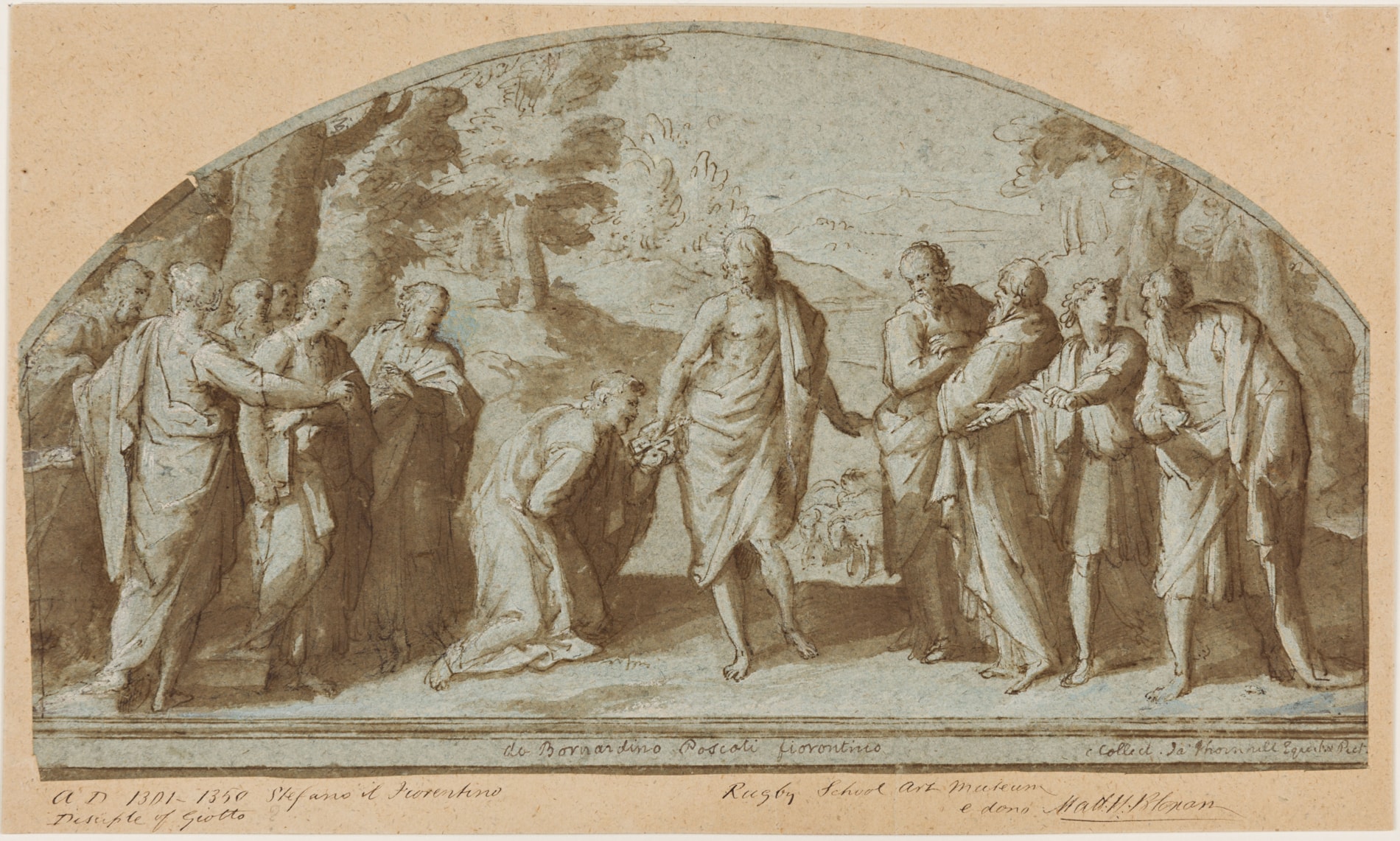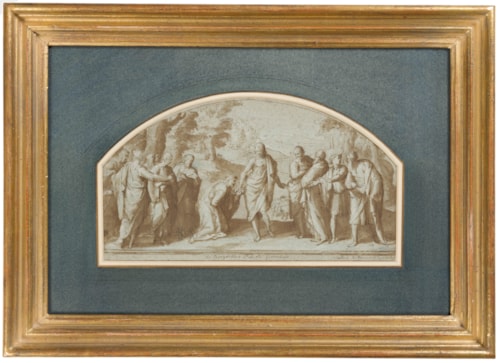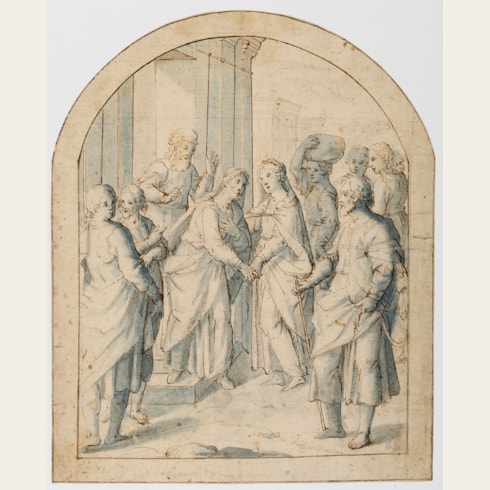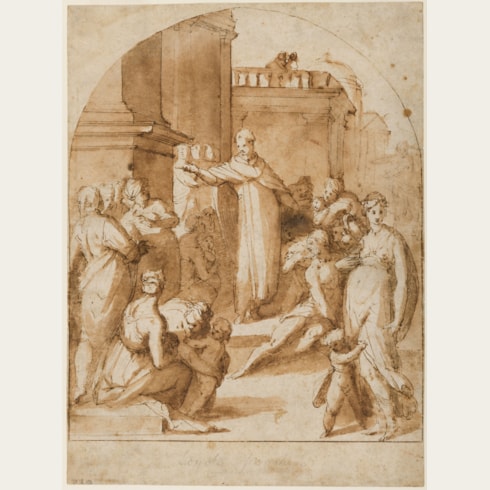Giovanni BALDUCCI
(Florence 1560 - Naples After 1631)
Christ Giving the Keys of the Kingdom of Heaven to Saint Peter (Traditio Clavium)
Inscribed de Bornardino Poscoli fiorontinio and collect Ja. Thornhill Eques. & Pict. at the bottom.
Inscribed MC and numbered No.55 on the verso of the backing sheet.
Further inscribed AD 1301-1350 Stefano il Fiorentino / Disciple of Giotto and Rugby School Art Museum / e dono Matt: H: Bloxam on the 19th century mount.
174 x 310 mm. (6 7/8 x 12 1/4 in.) at greatest dimensions.
The pose of Christ in this drawing is also close to that in an earlier fresco of The Appearance of Christ to the Apostles, painted by Balducci between 1586 and 1590 for the church of the Gesù Pellegrino (also known as the Oratorio dei Pretoni) in Florence. Among stylistically comparable drawings by the artist is a Birth of the Virgin in the Albertina in Vienna and a Last Supper in the Thrivent Financial Collection of Religious Art in Minneapolis, Minnesota.
As noted by the inscription at the bottom of the present sheet, the first recorded owner of this drawing was the English history painter Sir James Thornhill (1675-1734), who attributed it to the Florentine artist Bernardino Poccetti (1548-1612). The drawing later belonged to the antiquary and architectural historian Matthew Holbeche Bloxam (1805-1888), of Rugby in Warwickshire. Like his father before him, Bloxam had studied at Rugby School, of which he remained a devoted supporter throughout his life. When the school’s Art Museum opened in 1879, he began donating individual drawings from his collection to the museum on a yearly basis, often on his birthday.
The begining of the next decade found the artist working at the cathedral in Volterra, where he painted a Miracle of the Loaves and Fishes for the Serguidi chapel. In 1594, together with his fellow painter Agostino Ciampelli, Balducci was summoned to Rome by Alessandro de’ Medici to contribute to the decoration of his titular church of Santa Prassede. During the next two years in Rome he painted altarpieces for the churches of San Giovanni Decollato, San Giovanni dei Fiorentini, San Giovanni in Laterano and San Gregorio al Celio. He also painted an apse fresco for the cathedral in Velletri, commissioned from him by Cardinal Alfonso Gesualdo and completed in 1595. Soon afterwards, in the spring of 1596, Balducci travelled to Naples, in the retinue of Cardinal Gesualdo, to work on the decoration of the Duomo. He was to work in Naples and Calabria for more than thirty years, receiving numerous commissions for paintings and frescoes, notably a now-lost fresco cycle for the Palazzo Reale. Among the churches where he worked in Naples were San Giovanni dei Fiorentini, Santissima Annunziata, Santa Maria de Monteverginella and, towards the end of his life, Santa Maria del Carmine. Balducci also designed a number of tapestries, known as the Giornata di Seminara, for the Neapolitan nobleman Vincenzo Luigi di Capua. However, very little of his Neapolitan work survives today, and this period of his career remains relatively little known in comparison with his work in Florence and Rome.
Balducci’s early drawings, sometimes on prepared or coloured paper, show the particular influence of his master Naldini. Although he had a fairly distinctive style as a draughtsman, and produced a fair number of autograph drawings, those of his later Neapolitan period are less well-studied. Relatively few drawings by the artist can be connected with finished paintings or frescoes, and therefore establishing a firm chronology of his style as a draughtsman remains a challenge. A small but interesting group of drawings by Balducci is today in the Musée des Beaux-Arts in Lille, while other examples are in the Hessisches Landesmuseum in Darmstadt, the National Gallery of Scotland in Edinburgh, the Uffizi and the Biblioteca Marucelliana in Florence, the Wadsworth Atheneum in Hartford, the British Museum and the Courtauld Institute Gallery in London, the Biblioteca Nacional and the Museo del Prado in Madrid, the Staatliche Graphische Sammlung in Munich, the Louvre in Paris, the Istituto Centrale per la Grafica in Rome, the Biblioteca Reale in Turin and elsewhere.
Provenance
Matthew H. Bloxam, Rugby, Warwickshire
Presented by him to Rugby School, Rugby, Warwickshire, probably between 1879 and 1888.
Literature







